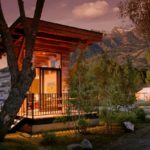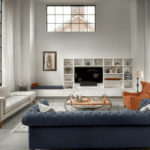Last updated on July 4th, 2024 at 03:02 pm
Building a custom home means having complete control over every aspect of design. There are dozens of architectural styles to base a custom home on, from historical approaches to modern interpretations. Look around the country and you will see nearly countless options. In the northeast, Colonial and Cape Cod-style homes dominate neighborhoods. The west has some of the best craftsman cottages and ranches, while the south has some of the finest Greek revival homes. The beauty of creating a custom home is having the freedom to pick the perfect architectural style that is practical and aesthetically pleasing.
There are many considerations that go into designing custom homes. Some climates are better suited for certain home designs. A home can have a typical roof pitch appropriate for snowy winter or a quintessential courtyard for sunny climates. The surrounding landscape and neighboring buildings are also huge factors when picking an architectural style for a custom home. Deciding on the final design for a custom home is always difficult and design inspirations can always help narrow down the choices. Taking a look at some of the most popular architectural styles in the country will be a great help when designing a custom home. This article will give a summary of each style by providing a bit of historical background, common characteristics, and examples.
Cape Cod
Cape Cod is a classic home style that can be traced back to the late 17th century. When Puritan colonists migrated to New England, they built half-timbered homes that were able to withstand the harsh weather. These homes were first seen in Massachusetts and would, later on, be named after Cape Cod, their region of origin.
Characteristics of Cape Cod Home
Reverend Timothy Dwight was the first person to describe Cape Cod homes in detail. He saw that these homes were made of either oak or pine, which were readily available resources and are durable enough to endure winter. These homes have low ceilings to avoid snow buildup on roofs and preserve the heat from the inside. A central chimney is another essential Cape Cod home feature.
The Cape Cod-style has evolved throughout the years and it has three variations: the half cape, three-quarter cape, and the full cape. The half cape or the single cape is the simplest variation and earliest example of the Cape Cod-style home. It can be characterized by a front door on one side and two multi-paned windows on the other. As years passed, families grew and the half cape expanded into the three-quarter cape. Much like the half cape, a front door is found on the side of a three-quarter cape home accompanied by two multi-paned windows on the side and a single window on the other. The most common variation found today is the full cape. Full capes homes were already present during the 18th century, but this style was only used by the wealthy. Unlike the half and three-quarter cape, a full cape home has a central front door with symmetrical windows on each side.

Example of a Cape Cod Home
The Cape Cod-style is still a popular choice for many homeowners and Architect Royal Barry Wills can be credited for its 20th-century revival. Wills is best known for being the father of Cape Cod Revival Homes. The Massachusetts local designed plans that were perfect for families seeking a classic suburban home. He made his plans readily available to many families, even selling his floor plans for a dollar. His efforts to make the Cape Cod-style more accessible popularized it with modern suburban neighborhoods.
Actor Dakota Fanning recently purchased a $2.95 million Traditional Cape Cod Home in Valley Village, Los Angeles. The 4,428 square-foot residence has five bedrooms and six baths. Guests walk into a double-height center hall with an elegant chandelier as the focal point. From the spacious center hall, the carved mantel fireplace in the formal living room will surely draw attention. The living room leads to the formal dining room that is also adorned with a crystal chandelier. The second floor features the impressive master suite, with its own fireplace, balcony, walk-in closets, and a master bathroom with a glass-enclosed steam shower.
Colonial
The Colonial home style is one of the oldest architectural styles that are still very common in many states. Its origins date back to the 17th century when European settlers built their homes inspired by the architecture of their countries. These different designs are the foundations of Colonial Architecture, which branched out to a variety of styles like French Colonial, Dutch Colonial, and Spanish Colonial.
Characteristics of a Colonial Home
Colonial homes are found in almost every state, and each region has a different interpretation. For example, New England homes are mostly made of wood, while Hudson Valley homes were made of brick and stone. There are many variations of Colonial architecture, but it has qualities that are quite distinct.
The exterior has a symmetrical design accented by dentil molding. There is often a central chimney found in the steep roof usually made of wood or bricks. Colonial homes are usually two stories with the family room on the first floor and the bedrooms are on the second floor. The staircase serves as the focal point of the home because it is the first thing people see when they enter a Colonial home.
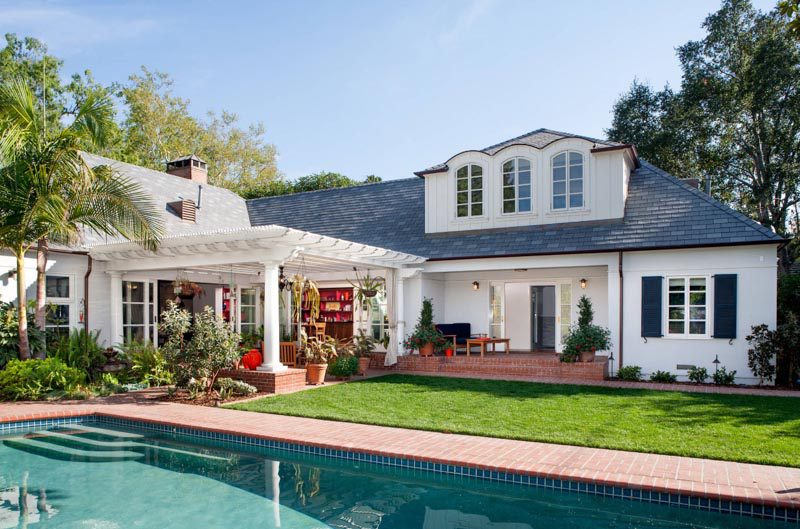
Example of a Colonial Home
Initially built in the 1940s, this Colonial home was purchased by its homeowners because they were enticed by its large private backyard and an outdoor pool. The interiors were very outdated but the homeowners wanted to revive the forgotten character of their Colonial home. The homeowners commissioned Jeff Troyer Associates to complete an extensive remodel of the whole home. The result was a two-phase plan that lasted for almost ten years.
The beautiful Colonial exterior was given a Midcentury Modern update that still has the essence of the original home. The blue roofing tiles were a nice compliment to the white exterior. Inside, a loft-type second floor was added. Maintaining a low exterior roofline while building the addition was a challenge for Troyer. But the result is a modern space that is a perfect spot for bookworms. When guests climb the stairs, they are welcomed by custom bookshelves that line the walls. The firm made sure that the library and home office was well-lit by strategically placing arched windows overlooking the swimming pool.
Craftsman
Similar to the bungalow styles, a craftsman home was born out of the Arts and Crafts movement. This style first appeared in California during the early 20th century and slowly moved eastward. The craftsman house was at its peak of popularity between 1905 and the 1930s and is making a strong comeback today. The simplistic architecture received backlash because it went against the elaborate Victorian style that preceded it. One of the most prominent early practitioners of the American Craftsman home was David Owen Dryden, who was responsible for more than 50 craftsman homes in the San Diego area alone.
Characteristics of a Craftsman Home
Craftsman style houses place an emphasis on natural materials and have a symmetrical structure. It has a low-pitched roof with hipped gables, overhanging eaves, and wide front porches with tapered columns or pedestals that extend to the ground level. Handcrafted stone and woodwork is also a common element. This style home lends itself to distinctive color combinations.
Craftsman homes have compact but open interiors that allow for better traffic and foster family interaction. Customized furnishing like built-in furniture, bookcases, cabinetry and even eating nooks are hallmarks of a craftsman home. Stylistically, bungalow and craftsman style houses place an emphasis on natural materials such as wood, stone, and brick. These homes are comfortable to live in and rich in detail.
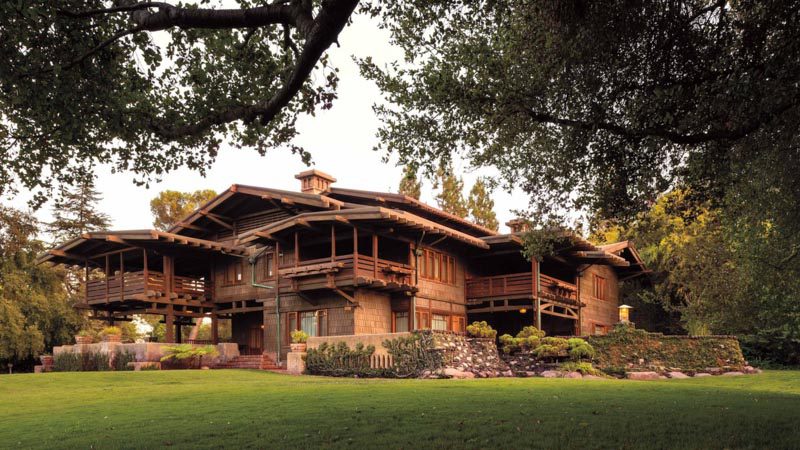
Example of a Craftsman Home
The Gamble House is one of the most famous craftsman homes in the country. Architectural Firm Greene and Greene designed the Gamble House from 1908 to 1909. It was supposed to be a winter home for husband-and-wife David and Mary Gamble. The Gamble House is the quintessential Arts and Crafts home. It uses natural materials and has unique craftsmanship that is still replicated to this day. Everything about the home reflects the pillars of the early craftsman style. Greene custom-made every feature of the home to complement rustic Pasadena.
Farmhouse
During the 17th century, agriculture was the livelihood of immigrants who settled in the country. They built their houses on agricultural lands and called them farmhouses. Now, the farmhouse is now as an architectural style pertaining to practical homes with a classic look.
Characteristics of a Farmhouse home
Besides being found in rural locations, the farmhouse style’s most recognizable feature is its outdoor porches. The front porch was important for homeowners who worked the field all day because it gave shade during hot summer days and it served as mudrooms or an area where they can leave dirty work boots. The materials used for the first farmhouses varied on the availability of resources. But now, most farmhouses are made of wood. The exteriors are reinforced by clapboards, overlapping horizontal wooden boards that limit wind and moisture from seeping into the foundation.
Modern farmhouse architecture stays true to the simple aesthetic of authentic farmhouses. Its exteriors are kept simple by flat boards rather than detailed crown moldings and simple square columns are used instead of the usual turned. Interior Designer Elizabeth Drake said the trick to achieving a tasteful modern farmhouse is straying away from decor that makes a home look too suburban. Colorful patterns are often used for modern farmhouse interiors to create a rustic palette.
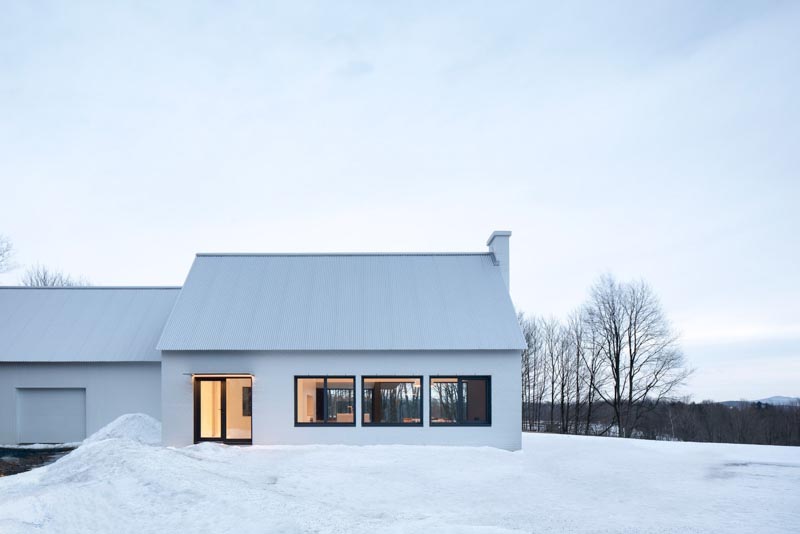
Example of a Farmhouse home
The Knowlton Residence in Quebec features both the traditional and classic elements of a farmhouse home. The gabled farmhouse was transformed into a white cedar-clad home. There are two sides to the home; the gorgeous white main house blends perfectly with its snowy landscape. Barns and agricultural sheds found in rural Canada served as the inspiration for the main house. Staying true to classic farmhouse principles, the home is made of natural materials commonly found in rural Canada. The modern addition is also made of locally sourced materials. Linked by a glass sliding door and metal framing, the contemporary addition is a dark contrast to the stark white main house. It is made of weathered wood and has large custom windows overlooking the snowy countryside.
Mediterranean Revival
Often found in Southern California, Mediterranean Revival architecture captures the charm of tropical getaways by bringing seaside villas to suburban neighborhoods. Mediterranean Revival architecture became popular in the country during the Roaring Twenties. Many resorts in California and Florida wanted to capture the coastal vibe of Mediterranean getaway spots. Mediterranean architecture attracted the wealthy and, soon enough, residential neighborhoods adapted it as well. Now, Mediterranean Revival is popular among exclusive communities that have grand estates and villas
Characteristics of a Mediterranean Revival home
Mediterranean Revival draws inspiration from many cultures, specifically Italian Renaissance and Spanish Revival. Influences from the Italian Renaissance can be seen in small geometric details and in the ornate decorative finishes. While the exterior has clear influences from Spanish Revival architecture. Mediterranean and Spanish architecture both have a low-pitched tile roof, stucco exteriors, and wrought-iron windows and balconies.
The goal of Mediterranean Revival homes is to give resort-style living space to homeowners. A rectangular floor plan is often used because it is easily navigable and it flows easily through the house. These homes also have a very lively color palette and patterned tiles are often used.
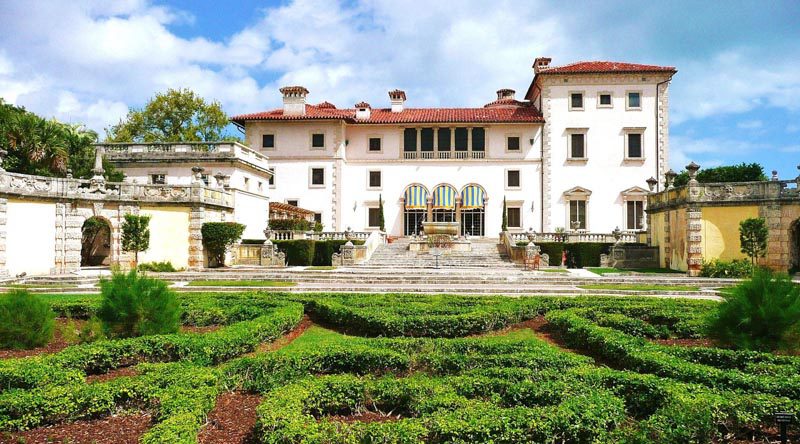
Example of a Mediterranean Revival home
The Villa Vizcaya was the grand villa and estate of businessman James Deering. It is one of the most famous Mediterranean houses in Florida. The 180-acre estate was designed by famed architect Francis Burrall Hoffman. He designed a Mediterranean estate inspired by Tuscan Italian Renaissance and Baroque elements. The Villa Vizcaya is known for being one of the first homes in South Florida to integrate European aesthetics. The Italian Renaissance garden was inspired by French and Italian garden lay-outs. Local plants and Floridian coral architectural trim were used due to the Florida climate. Instead of the usual floral gardens of France, Palms and Philodendrons were used.
Modern
The first half of the 20th century marked the birth of modern architecture. After the Second World War, experimentation with construction technology was prevalent. Glass, steel, and concrete were not confined to a home’s structure anymore. Architects started using these materials for design. Modern architecture was inspired by the historical art movement of modernism and was a rejection of the traditional neoclassical architecture that had been popular throughout the 19th century.
Characteristics of Modern home
A common misconception is that modern architecture is the same as contemporary. Although related, contemporary architecture simply refers to current architectural trends. So contemporary architecture is not limited to one specific style, but it has been narrowed to exclude certain historical styles. That being said, a lot of contemporary architecture today borrows many elements from modern architecture.
Modern architecture refers to creations that are inspired by the historical modernism movement. Modernism came about during industrialization as an effort to make architecture more functional while maintaining its simplicity. Ludwig Mies Van der Rohe is one of the famous architects who developed modern architecture. Rohe was the first architect to design the open office concept. This inspired many residential architects to design homes without partitions or detached rooms. A modern home has an open floor plan and values function over form.
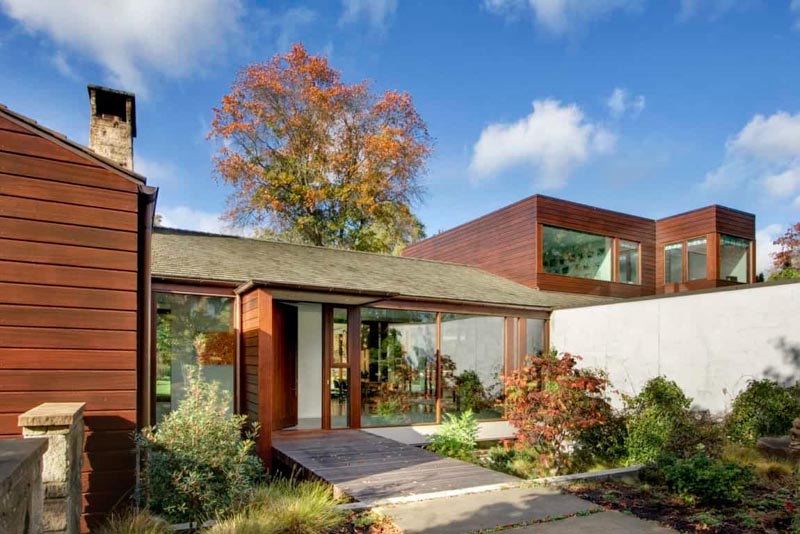
Example of a Modern Home
Originally built in the 1970s, David Coleman Architecture renovated this Broadmoor residence into a modern living space. The exterior is made of wood planks that complement its green location in Seattle. Most of the furnishing is also made of wood, and the interior design is very minimalist. The Brentwood home has an open floor plan paired with a function-oriented interior. The large overlooking windows bring in natural light and, in turn, make the residence look bigger.
Prairie
Developed by celebrated American Architect Frank Lloyd Wright, Prairie architecture is creating a home inspired by its environment. Wright wanted a home that would improve a family’s holistic wellbeing so he designed Prairie homes to be harmonious with the environment. The Prairie style is also the first modern residential architecture that precedes European modernism and the Craftsman style.
Characteristics of a Prairie Home
Staying true to green principles, Prairie-style homes are made with natural materials like wood, brick, or stucco. The style also keeps details simple by keeping everything horizontally oriented. The home has a low-slung flat roof that is also horizontal, and a free-flowing layout. Wright designed the Prairie home like a public space. An asymmetrical floor plan centered on living spaces like the living and dining room is often used for Prairie homes. Wright’s goal for the Prairie’s floor plan is to connect the indoor and outdoor spaces.
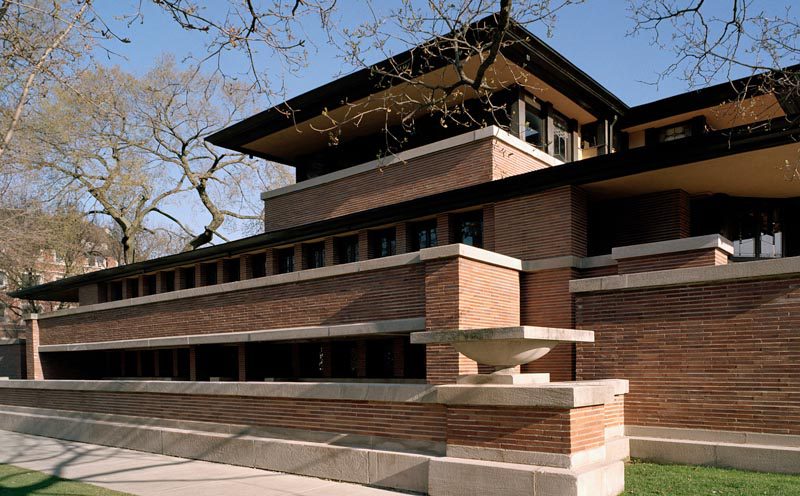
Example of a Prairie Home
The Robie House in Chicago is one of Wright’s most iconic Prairie homes. When Wright designed the home in 1910, its horizontal-oriented facade was regarded as trendsetting in the American architectural industry. At the time, many architects were designing homes that were inspired by European architecture. Wright knew that the Prairie style was more suited for the Midwest because it utilizes natural materials that are common in the area. Many design critics regard the Robie House as America’s first unique architectural style. It went against the romantic European facades that were common during its time. Instead, the Robie House had a more compact structure, with low-set balconies and overhanging flat roofs that gave it inhabitants more privacy.
Ranch
The ranch home, also known as a rambler, is typically a single-story home with a long horizontal footprint. It was popularized in the 1950s and often attributed to California architect Cliff Mays and made fashionable by Frank Lloyd Wright. This postwar style celebrated the profusion of cheap land and the sprawling suburbs
Characteristics of a Ranch Home
The original style of the ranch was no-frills and basic. Ranch homes embraced a less-formal lifestyle and have open and free-flowing floor plans. Standard features include a long, low roofline and simple, open layouts. As ranches became more common it incorporated more dramatic features such as varying rooflines and cathedral ceilings, but the basic premise remains the same. Ranches are usually one-story, but the raised ranch is a two-story adaptation with a finished basement.
Ranches are typically rectangular, L-shaped, or U-shaped. The long horizontal structure allows for easy connection to the outdoors, and most rooms have a view of both the front and the back of the home. The long layout of the ranch also allows for an easy division between living and sleeping spaces. And because of the structure of a ranch home, future additions are often fairly simple.

Example of a Ranch Home
Many modern ranch homes have taken a more sustainable approach to design. For example, this Caterpillar House in California is the first home in the Central Coast to be rated Platinum by the Leadership in Energy and Environmental Design (LEED). The homeowners are fans of the farmhouse style and wanted a contemporary version that is also good for the environment. Feldman Architecture took advantage of the sprawling Santa Lucia Preserve. The walls are made from excavated earth that curve to home’s contours. It acts as a thermal mass that regulates the home’s temperature. Besides the environmental-friendly features, the home stays true to classic ranch elements. It has a traditional low and horizontal orientation and an open floor plan with the kitchen as the focal point.
Transitional
Transitional architecture is a blend of classic and contemporary styles. The term “transitional” was used by interior designers who combine modern and traditional design elements. Using two styles for one space was common with interior design and, now, transitional architecture is all the rage.
Characteristics of a Transitional Home
Since transitional architecture is a mix of different styles, it does not have distinct characteristics. But transitional architecture can be easily identified because it does not really fit into a specific genre. It takes together opposing elements from very different styles and creates homes with a neutral aesthetic. These different elements can be observed in the column, railing, siding, and color details. Industrial elements like rough metal sidings or steel beam-columns are paired with classic decors like Victorian ceilings.
A neutral color palette is always used with transitional architecture. Textural elements are incorporated to make the neutral palette standout. Combining very different style elements can be overwhelming hence transitional style is all about keeping the design simple. Ornaments are kept at a minimum and impactful art pieces are usually the focal points of a Transitional home. A large conversation piece is perfect for the modern living space.
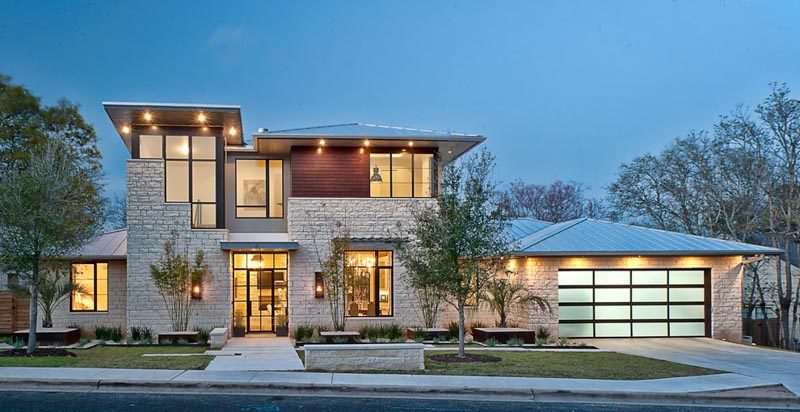
Examples of a Transitional Home
This Cat Mountain Residence is a great example of a transitional-style home. From the mismatched windows to its rectangular silhouette, the home’s architecture is very contemporary but its rustic finish is out of character. Giving a transitional design was ideal because the homeowner wanted a modern home with an antique charm. The combination of steel, limestone, and wood gave a nice textural accent to the beige exterior. The black French door tastefully showcases both vintage and contemporary themes of the home. It retains the simple structure of the French door but using windows instead of wood gave it a contemporary edge.
Victorian
The Industrial Revolution paved the way for architectural freedom, involving elaborate architectural styles that had an emphasis on aesthetics rather than functionality. During the reign of Queen Victoria, a lot of romantic architecture was produce and inspired this genre of homebuilding.
Victorian-style homes were born out of the freedom afforded by the industrial revolution as new technologies gave way to building techniques capable of such elaborate details. This architecture emerged between 1830 and 1910 during the reign of Queen Victoria. Common sub-styles include Gothic Revival, Italianate, Second Empire, Queen Anne, and Romanesque style.
Characteristics of a Victorian Home
Victorian homes are elaborate homes with intricate details inside and out. Typically two stories, Victorian homes are built more for beauty than functionality. They have asymmetrical floor plans, steep roof pitches with dormers, large ornate porches, and grand towers and turrets. Stylistically, these homes often have ornate trim, bright, whimsical colors, eyebrow windows, and decorative railings.
These homes often have complex floor plans with a series of rooms scattered around. The benefit is that you can arrange rooms across the 2 or 2.5 floors as you desire. Irregular room shapes offer plenty of opportunities for bay windows, cozy seating, and intimate dining areas in the home’s unique shape, caused by towers and turrets, which means it has an abundance of windows. The large porches that wrap around the home allow for indoor/outdoor living and can be connected to multiple rooms.

Example of a Victorian Home
This antique home in Carver, Minnesota is the preserved 1856 Victorian home of the town’s first sheriff. The intricate Queen Anne-style woodwork was repurposed and the same wood from the original house was used. Everything that was found in the original home was preserved. The interiors have wide plank Fir floors, transom windows, and a vintage fireplace in the family room. The interior design might be too much for some but it’s actually very period-appropriate. Colorful floral wallpapers were common at a time and it was always paired with elaborate light fixtures. Different wallpapers and furnishings are used for every room. It captures the shabby chic aesthetic that was unique and distinct with Victorian-era design.



